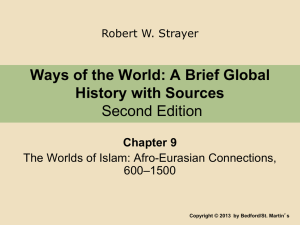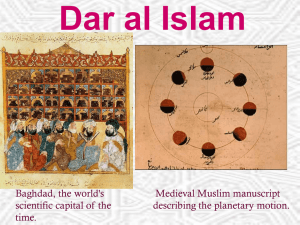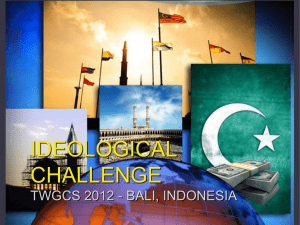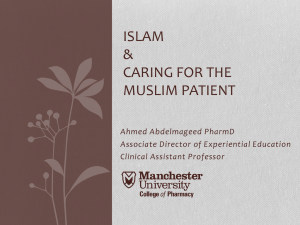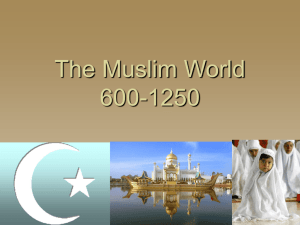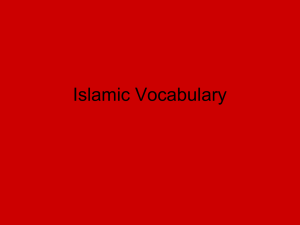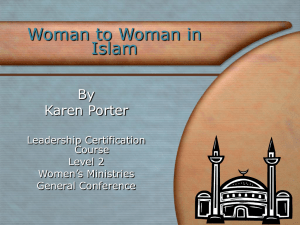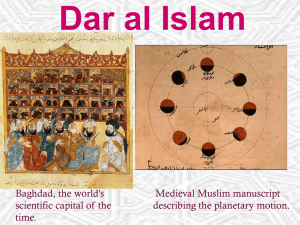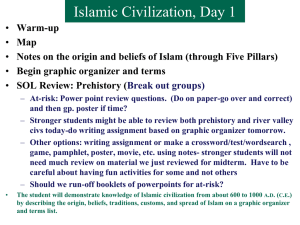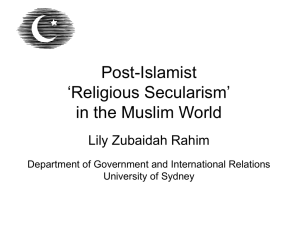Islam Flipped Assignment
advertisement
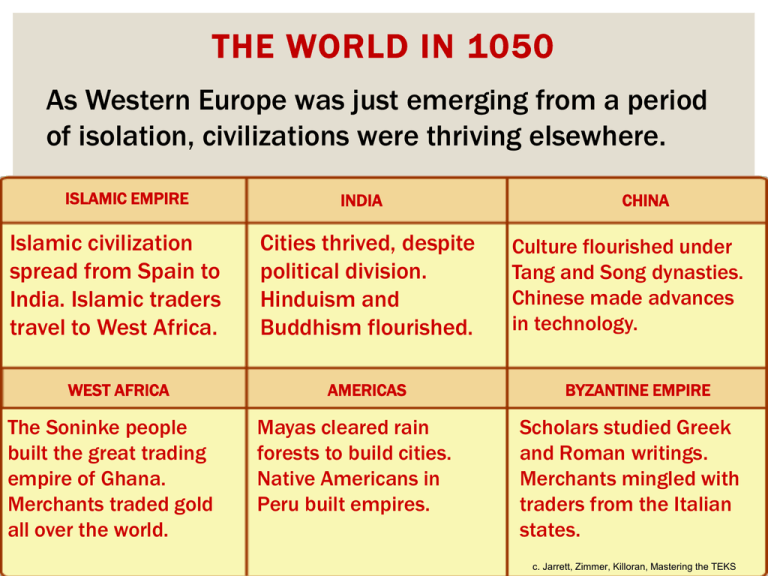
THE WORLD IN 1050 As Western Europe was just emerging from a period of isolation, civilizations were thriving elsewhere. ISLAMIC EMPIRE INDIA Islamic civilization spread from Spain to India. Islamic traders travel to West Africa. Cities thrived, despite political division. Hinduism and Buddhism flourished. WEST AFRICA AMERICAS The Soninke people built the great trading empire of Ghana. Merchants traded gold all over the world. Mayas cleared rain forests to build cities. Native Americans in Peru built empires. CHINA Culture flourished under Tang and Song dynasties. Chinese made advances in technology. BYZANTINE EMPIRE Scholars studied Greek and Roman writings. Merchants mingled with traders from the Italian states. c. Jarrett, Zimmer, Killoran, Mastering the TEKS THE RISE OF ISLAM THE RISE OF ISLAM In the fifth century, warfare between the Byzantine and Persian Empires interrupted overland trade routes from East Asia. Trade in spices, Chinese silks, and Indian cottons, shifted to the sea routes connecting India with Arabia and the Red Sea. Overland caravans carried goods up the western coast of the Arabian Peninsula. Cities and towns developed near wells along these caravan routes, including Mecca. In the 7 th centur y, a new religion emerged here: Islam. The term Islam is Arabic for submission. Within a hundred years, Islam grew to control an area larger than the Roman Empire. c. Jarrett, Zimmer, Killoran, Mastering the TEKS MOHAMMED: THE PROPHET OF ISLAM Mohammed, the founder of Islam, worked in Mecca as a merchant and shepherd. In 610, Mohammed had a vision that the Angel Gabriel told him to convert the Arab tribes, who then believed in many gods, to belief in a single God, known in Arabic as “ALLAH.” Muslims are strict monotheists. They believe in the JudeoChristian God, which they call Allah . Muslims believe that the Torah and the Bible , like the Qur’an is the word of God. Islam An Abrahamic Religion 622 Hijrah Mohammed flees Mecca for Medina. * The beginning of the Muslim calendar (1 A.H.) Mohammed's revelations were compiled into the Qur’an after his death. Mohammed will gather his followers to retake Mecca in a jihad. The Qur’an Sacred text of Islam: Muslims believe it contains the word of God as revealed to Mohammad 114 suras or chapters In the name of Allah, the compassionate, the merciful. Written in Arabic – responsible for the spread of the Arabic language in the Middle East THE FIVE PILLARS OF ISLAM 1. The Faith or SHAHADAH – Muslims must affirm: “There is no God but Allah and Mohammed is his prophet. 2. The Prayer or SALAT – Muslims must pray five times a day, while facing east towards the city of Mecca. 3. The Alms or ZAKAT – Muslims must give money to the poor and pay taxes to the mosque. 4. The Fast or SAWM – During the month of Ramadan, Muslims cannot eat or drink during daylight hours. 5. The Pilgrimage or HADJ – If physically able, a Muslim must make a pilgrimage (religious trip) to Mecca during the 12th Islamic month. Sunni: أهل السنة والجماعة • “Sunni” – in Arabic come from a word meaning “one who follows the traditions of the Prophet” • caliph (leader) should be chosen by leaders of the Muslim community • caliph should be a pious Muslim • he is a leader, not a religious authority Shi’a شيعة • “Shia” in Arabic means a group or supportive party of people • historically, Shia Muslims have not recognized the authority of elected Muslim leaders (Sunnis) • follow a line of imams (prayer leaders in mosques) they believe were appointed by the Prophet or God Himself ISLAM INFLUENCES LAW & GOVERNMENT IN MUSLIM WORLD Sharia body of Islamic law to regulate moral conduct, family life, business practices, government, and other aspects of a Muslim community. Applies Qur’an to all legal situations. Interpretation of Sharia varies between Sunni and Shi’a sects of Islam. ISLAM SPREADS- UMAYYADS By the time of Mohammed’s death almost all of Arabia had converted to Islam, but now the tribes were united under one cause, one language (Arabic), and one religion. However, by this time the Byzantines and Persians were both weakened from centuries of fighting each other (power vacuum) and Arab Muslims succeeded in creating a vast empire that extended from the Indus Valley into Europe as far west as Spain, where it was halted at the Battle of Tours. Under the first four Caliphs (successor to Mohammed) Islam will expand rapidly. These leaders will be known as the Umayyad Caliphate. The wars of expansion were also advanced by the devotion of the faithful to the concept of jihad. Muslims are obliged to extend the faith to unbelievers and to defend Islam from attack. Age of the Caliphs • Expansion under Mohammad, 622– 632/A.H. 1-11 • Expansion during the Rashidun Caliphate, 632–661/A.H. 11-40 • Expansion during the Umayyad Caliphate, 661–750/A.H. 40-129 ABBASID CALIPHATE 750 - the Abbasids took over the caliphate. The Abbasids will focus on trade rather than war. Move capital to Baghdad (House of Wisdom) that preserved and translated scientific/medical documents into Arabic. Achievement: algebra & astrolabe Muslim rulers treated Jews and Christians (People of the Book) with respect since they believed to worship the same God. Permitted to have self-governing communities. Had to pay a special tax & could not hold some public office. GOLDEN AGE OF MUSLIM CULTURE While learning was in decline in Western Europe, a Golden Age of Muslim Culture flourished– a period of great advances in culture and technology. Mathematics: Arab scholars borrowed the concept of zero from India and developed algebra and geometry. Arts and Crafts: Mohammed forbade making images of God or people. Islamic art is largely made up of geometric designs, flowers, and stars. Their textiles, leather works, and rugs are highly prized. Medicine: Arab doctors discovered that blood moves to and from the heart. They learned to diagnose many diseases, including measles and smallpox. Architecture: Muslim rulers built beautiful palaces and mosques, richly decorated with mosaics, calligraphy, and geometrical designs. Arab Muslims absorbed the cultural achievements of the Greeks, Persians, Romans, Jews and Byzantines. They also controlled a trading area larger than the ancient Roman Empire had been. Goods from India, China, Africa, Spain, and the eastern Mediterranean entered through Arab territories. ISLAMIC WORLD IN LATER YEARS The rich Islamic Empire attracted invaders from Central Asia: In the 11th century Baghdad was captured by the Seljuk Turks, a Turkish tribe from Central Asia. However, the Seljuk Turks converted to Islam and Baghdad remained the capital of their new empire. In the 12th century, Muslims warred with the Christians over control of the Holy Land in the Crusades. Christians captured Jerusalem in 1099, but the city was later retaken by the Muslim leader and warrior, Saladin (11371193). Saladin remains a hero to the Islamic world for uniting the Arabs and defeating the Crusaders in battle. GROWTH OF ISLAM • 1.6 billion Muslims today – expected to be 2.5 billion by 2030 • Asia/ Africa/ Pacific Region • 7 out of every 10 a Muslim • Fastest growing religion in the world 1. Indonesia 183,000,000 6. Iran 62,000,000 2. Pakistan 134,000,000 7. Egypt 59,000,000 3. India 121,000,000 8. Nigeria 53,000,000 4. Bangladesh 114,000,000 9. Algeria 31,000,000 10. Morocco 29,000,000 5. Turkey 66,000,000
